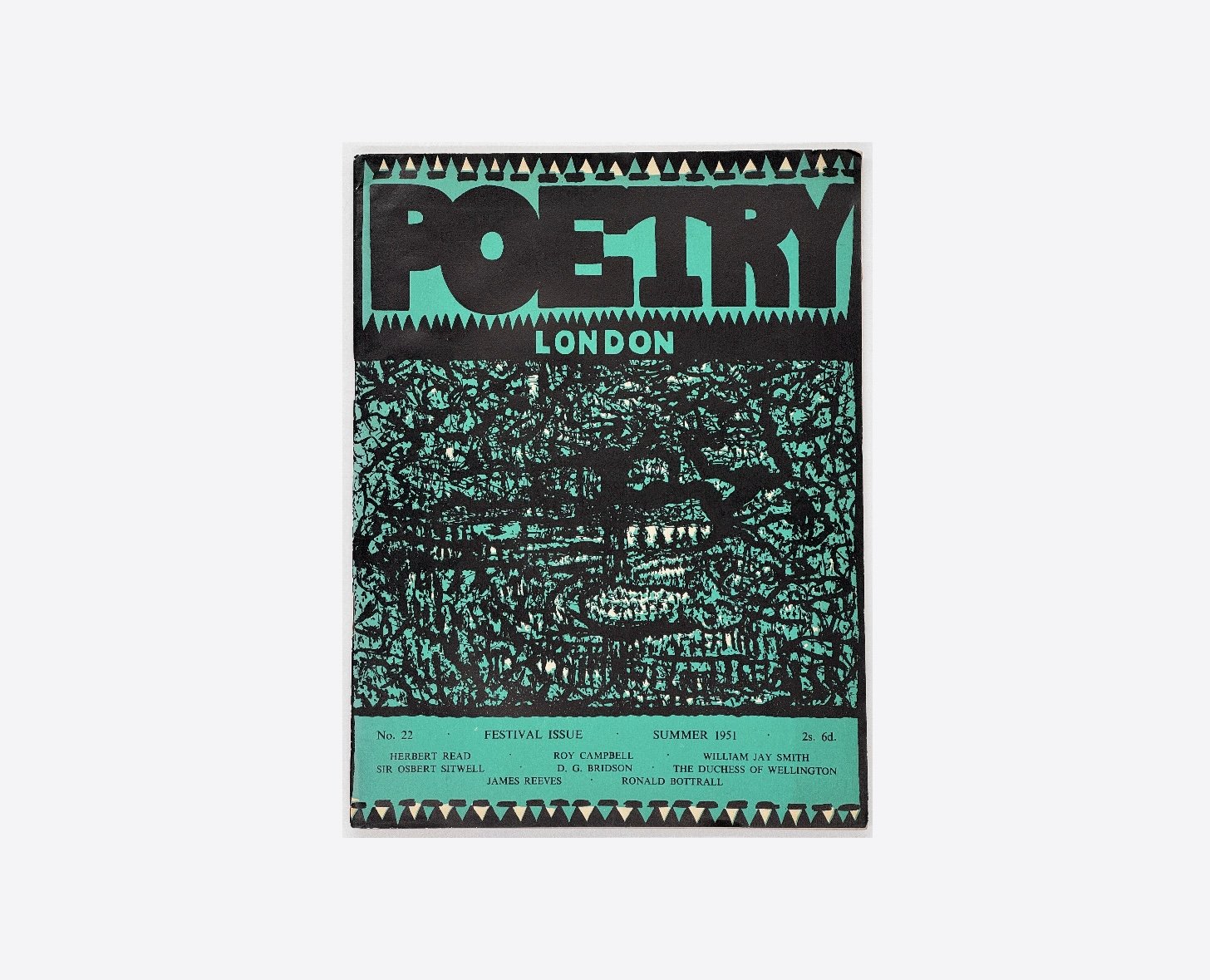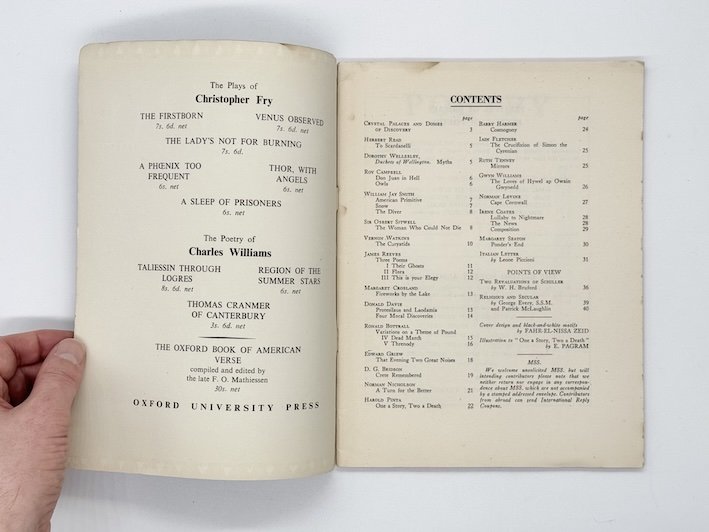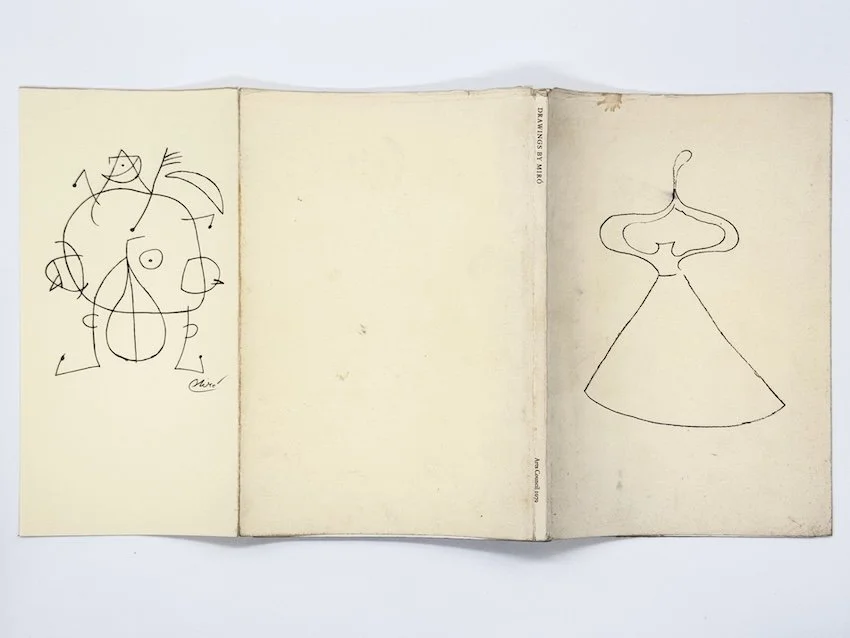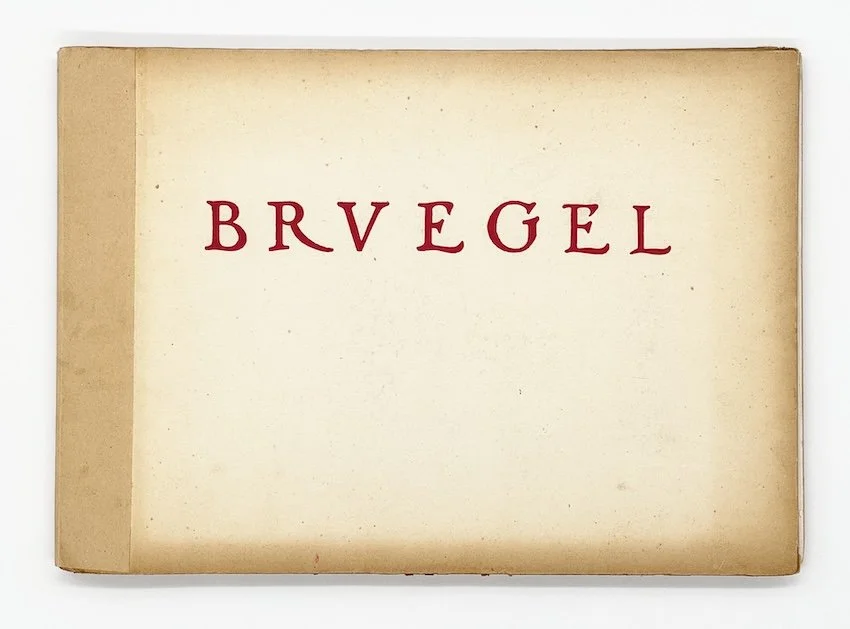 Image 1 of 2
Image 1 of 2

 Image 2 of 2
Image 2 of 2



Poetry London, Vol. 6, No.22 FESTIVAL ISSUE Summer 1951. Cover design by Princess Fahr-El-Nissa Zeid
Princess Fahrelnissa Zeid (1901-1991) was a Turkish-born artist, part of the avant-garde scenes in 1940s Istanbul, and post-war Paris. She was one of the first women to study at an art school in Istanbul. Her work has been exhibited at various institutions in Paris, New York, and London, including the Institute of Contemporary Art (1954), Tate Modern (2017) and Centre Pompidou (2021).
This issue edited by Richard March and Nicholas Moore. Includes the poem "One a Story, Two a Death," which is the third published appearance by Nobel laureate Harold Pinter, credited here as Harold Pinta. Other contributors include Herbert Read, Osbert Sitwell, Roy Campbell, D.G. Bridson, William Jay Smith, James Reeves, and Ronald Bottral, and others. The publisher's subscription form laid in.
Title: Poetry London, Vol. 6, No.22 FESTIVAL ISSUE Summer 1951
Publisher: Editions Poetry London
Publication date: SUMMER 1951
Design: Fahr-El-Nissa Zeid
Format: Stapled wraps
Pages: 40
Images: cover design by Fahr-El-Nissa Zeid
Condition: Very good
Stock Number: RB01199
Meary James Thurairajah Tambimuttu and Anthony Dickins launched Poetry London in 1939, with Tambimuttu as literary editor and Dickins as general editor, but it was Tambimuttu who was the driving force behind it. Well regarded in the literary world, Poetry London and Tambimuttu in particular occupied a central role within the literary and artistic networks of 1940s London and later New York City. The magazine featured the work of many of the most influential British poets of the period, including Lawrence Durrell, W. H. Auden, Louis MacNeice and Stephen Spender, as well as reviews of poetry, fictions, plays, literary magazines and scholarly work, and some short prose, critical essays and illustrations. It also published work by new poets, declaring in its first editorial that 'every man has poetry within him'. Indeed, T. S. Eliot said of the magazine: 'It is only in Poetry London that I can consistently expect to find new poets who matter'. Initially funded by subscriptions and donations, and frequently suffering from paper shortages during the Second World War, the magazine was beset by financial difficulties and appeared irregularly. From 1942 to 1947, it gained the backing of publishers Nicholson & Watson, who also asked Tambimuttu to develop his own imprint of books, Editions Poetry London. As well as writers, Editions Poetry London promoted several artists, publishing work by Barbara Hepworth and Henry Moore, among others. After Nicholson & Watson withdrew their support in 1947, the magazine gained the financial backing of Richard March until its demise in 1951.” – Ref: British Library
Princess Fahrelnissa Zeid (1901-1991) was a Turkish-born artist, part of the avant-garde scenes in 1940s Istanbul, and post-war Paris. She was one of the first women to study at an art school in Istanbul. Her work has been exhibited at various institutions in Paris, New York, and London, including the Institute of Contemporary Art (1954), Tate Modern (2017) and Centre Pompidou (2021).
This issue edited by Richard March and Nicholas Moore. Includes the poem "One a Story, Two a Death," which is the third published appearance by Nobel laureate Harold Pinter, credited here as Harold Pinta. Other contributors include Herbert Read, Osbert Sitwell, Roy Campbell, D.G. Bridson, William Jay Smith, James Reeves, and Ronald Bottral, and others. The publisher's subscription form laid in.
Title: Poetry London, Vol. 6, No.22 FESTIVAL ISSUE Summer 1951
Publisher: Editions Poetry London
Publication date: SUMMER 1951
Design: Fahr-El-Nissa Zeid
Format: Stapled wraps
Pages: 40
Images: cover design by Fahr-El-Nissa Zeid
Condition: Very good
Stock Number: RB01199
Meary James Thurairajah Tambimuttu and Anthony Dickins launched Poetry London in 1939, with Tambimuttu as literary editor and Dickins as general editor, but it was Tambimuttu who was the driving force behind it. Well regarded in the literary world, Poetry London and Tambimuttu in particular occupied a central role within the literary and artistic networks of 1940s London and later New York City. The magazine featured the work of many of the most influential British poets of the period, including Lawrence Durrell, W. H. Auden, Louis MacNeice and Stephen Spender, as well as reviews of poetry, fictions, plays, literary magazines and scholarly work, and some short prose, critical essays and illustrations. It also published work by new poets, declaring in its first editorial that 'every man has poetry within him'. Indeed, T. S. Eliot said of the magazine: 'It is only in Poetry London that I can consistently expect to find new poets who matter'. Initially funded by subscriptions and donations, and frequently suffering from paper shortages during the Second World War, the magazine was beset by financial difficulties and appeared irregularly. From 1942 to 1947, it gained the backing of publishers Nicholson & Watson, who also asked Tambimuttu to develop his own imprint of books, Editions Poetry London. As well as writers, Editions Poetry London promoted several artists, publishing work by Barbara Hepworth and Henry Moore, among others. After Nicholson & Watson withdrew their support in 1947, the magazine gained the financial backing of Richard March until its demise in 1951.” – Ref: British Library
















![Paul Colin, Edouard Manet. Published by Librarie Floury, Paris, 1932 [Signed by Paul Colin]](https://images.squarespace-cdn.com/content/v1/5e663714082b255903e382d7/912d9309-16df-4569-abc3-95cd762e62f3/IMG_0227.jpg)
![Paul Colin, Edouard Manet. Published by Librarie Floury, Paris, 1932 [Signed by Paul Colin]](https://images.squarespace-cdn.com/content/v1/5e663714082b255903e382d7/44ac018e-c07c-4350-befa-42961426131c/IMG_0202+2.jpg)
![Paul Colin, Edouard Manet. Published by Librarie Floury, Paris, 1932 [Signed by Paul Colin]](https://images.squarespace-cdn.com/content/v1/5e663714082b255903e382d7/22b0930d-541c-4d7a-a150-c094257291fb/IMG_0203.jpg)
![Paul Colin, Edouard Manet. Published by Librarie Floury, Paris, 1932 [Signed by Paul Colin]](https://images.squarespace-cdn.com/content/v1/5e663714082b255903e382d7/a4a25e74-ae0b-4e5d-b191-aebff24fb381/IMG_0204.jpg)